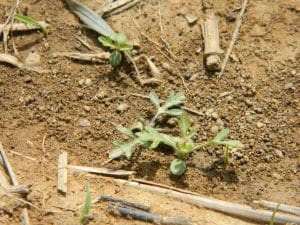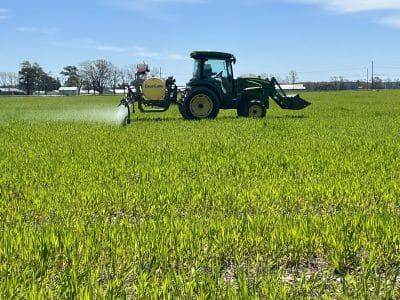
Common ragweed has already emerged in row crops and pastures around the country. Like most summer annual weeds, applying herbicide treatments now when they are still small will target them when they are most vulnerable and help ensure full control prior to planting. Herbicide resistant populations of common ragweed exist in many states, with some even having multiple-resistance to herbicide groups 2, 9, and 14. Herbicide resistant populations require diversified management practices fr effective control.
Here are some general integrated weed management guidelines for common ragweed:
- Plant into weed-free soil by controlling all ragweed seedlings prior to planting
- If tilling, till at night and/or pre-plant burndown herbicides. Tillage during the day stimulates seedling germination
- If tilling, till in the mid-late spring after ragweed seeds have germinated
- Scout often to catch plants before they reach 4-6 inches tall
- Scout 2 weeks after the first post-emergence herbicide application
- Apply herbicides to plants under 4-6 inches tall for optimal control
- Where herbicide-resistant populations are present, avoid using the herbicide groups they are resistant to, and diversify tank mixes with at least two other effective herbicide sites of action.
- A rotation of small grains overseeded with clover suppresses ragweed. Ragweed also does not tolerate mowing well.
In pasture settings:
- Keep pasture full and competitive.
- Mow after bolting to prevent seed production.
- Apply an effective herbicide in early summer.
- Prevent seed production to prevent spread.
Herbicide resistant populations:
- Group 2 (ALS)
- Group 9 (glyphosate)
- Group 2 + 9
- Group 2 + 14 (PPO inhibitors)
- Group 2 + 9 + 14
Locations of resistant populations:
Alabama, Arkansas, Delaware, Illinois, Indiana, Iowa, Kansas, Kentucky, Maryland, Michigan, Minnesota, Mississippi, Missouri, Nebraska, New Jersey, North Carolina, North Dakota, Ohio, Pennsylvania, Tennessee, South Dakota, Virginia, Wisconsin (Search by State to find which resistant populations are present in each state)


